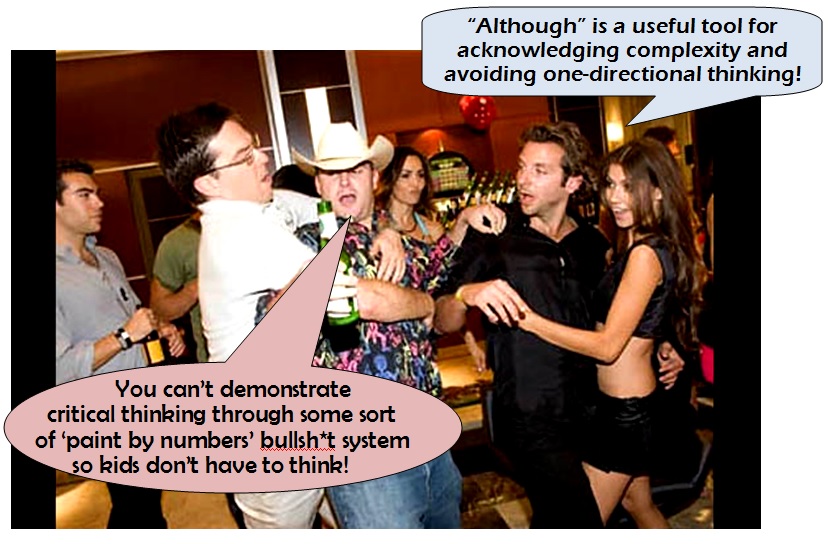There are essentially THREE types of writing we’re likely to do in school. I realize I’ve just dared purists out there to shake their little mechanical pencils at me and explain how really there are 17 distinct types of writing not counting Haiku or whatever, but I teach 9th Grade. So there are three.
Narrative Writing essentially tells a story. It can be real or imagined, or some combination of the two. It usually starts at the beginning, moves through the middle, and ends at the end. Most popular fiction is in narrative form, as are most movies. ‘History’ history books (U.S. History, Texas History, European History, etc.) tend to structure themselves as narratives. If I cared what you did over your summer vacation (I don’t), you’d tell me in narrative form as well.
There’s nothing wrong with a good narrative, but that’s not the kind of writing we’re working on right now.
Informative / Explanatory Writing is any type of writing which takes a collection of related, but often complicated, information and tries to organize and present it so that it makes sense. Most Biology textbooks don’t begin with “Once upon a time, there was a lonely protozoa in a pool of primordial ooze. One day, he decided he was bored and that it was time to split – literally…” They may begin with the foundations of biology, or why we study biology, or share a bit about the first people to demonstrate an interest in this particular science, etc., but it’s not chronological. Different books on the same subject may organize the same basic information in different ways and it still works. Math books, American Government books, or anything “For Dummies” are Informative/Explanatory.
When I have students do Quick-Writes, they’re usually informative/explanatory. That’s not the kind we’re talking about right now, however. That leaves…
Argumentative Writing attemps to use facts and reason to support a point or an interpretation. It’s all logical and stuff.
But “argument” is a loaded word for many of our students. It’s what happens when a friend is mad at them, or when their boyfriend is about to break up with them. It’s what Mom & Dad do after they think you’re asleep – especially when Dad’s been ‘doing it’ again. It’s the entire plot of many “Reality TV” shows.
But in an academic context, argument isn’t a bad thing at all. In fact, it’s crazy beneficial. It’s how science is supposed to work – great minds doing research and writing papers primarily so other great minds can criticize and question everything about them and explain why they’re flawed or incomplete. It’s our preferred format for difficult legal questions, whether determining the constitutionality of a company policy or trying to figure out if you actually stole that car before or after the body was stuffed in the trunk.
And it’s how history and its interpretation(s) get sorted out. It’s why there can be a dozen different explanations for the Salem Witch Trials or Pickett’s Charge although the sum total of primary source material hasn’t changed drastically. Historians major and minor wrestle with the available information and argue their viewpoints using proof and reason (well, that’s how it’s supposed to work, anyway). Over time, concensus often emerges. If not, the process continues.
Unlike scientists or politicians, historians are pure and without bias, seeking only the truth. We’re practically HOLY.
When I tell students that ‘winning’ is not generally the goal of academic argument, they are understandably suspicious. This DOES sound a little too much like that “everyone’s special in their own way” and “no set of beliefs is any more or less workable or useful or true than any other random set of beliefs” feel-good tripe with which they’ve been harangued since birth – and which they can repeat back more easily than believe.
But it’s not meant in a touchy-feely way. A weak or stupid argument is still weak or stupid. An unsupported claim is still unsupported and will receive the belittling and hostility it deserves.
In academic argument, however, it is through analytical argument that we broaden our understanding of people, events, or issues. Take a look at this cartoon:
I like this cartoon by way of example because the facts are not in question. The girl in the bikini KNOWS she’s in a bikini, and the girl in the burqa KNOWS she’s in a burqa. Where they differ is in what to make of the available information. They disagree as to interpretation, and importance, of what they know.
Bikini Girl could certainly make an argument for her assertion regarding Burqa Girl’s culture. She could use logic and reason and bring in other information to support her case. Burqa Girl could do the same for her stand regarding Bikini Girl’s culture. Formulating each argument would help to clarify and strengthen the thinking of each, and might even expose weaknesses in their thinking just by going through the process.
But you know what would REALLY hone each argument? If they went to get coffee and discussed it – NOT simply to coddle one another and be all accepting, but to rationally and with open minds probe and argue and question and challenge one another’s assertions and interpretations. Neither may leave persuaded, but they may find their interpretations modified and their understanding broadened. A Venti of learning goodness, extra mocha.
That’s just an example, of course – I don’t really want it to HAPPEN in this case. I LIKE living in a cruel, male-dominated culture. Your outfit’s fine, honey. Don’t let anyone else, er… “oppress” you by telling you otherwise. You’re actually, um… proving your INDEPENDENCE by dressing that way. Shake it, modern girl, shake it.
You may remember this classic from Monty Python’s Flying Circus:
Hopefully it goes without saying that the customer was correct – that was NOT an argument. But at least that sketch was intended to be funny. This was intended to be policy analysis:
What was the subject? The main points? Anything?
None of these three panelists are stupid, although you wouldn’t know that from this clip. It’s getting increasingly difficult to distinguish policy discussions from reality TV. For example, this tense moment from the first Trump / Clinton Presidential Debate:
Perhaps it would be better to begin with written arguments, since that is after all the skill towards which we’re building.
Also, there’s less slapping.
RELATED PAGE: Looking at the Arguments of Others
RELATED POST: 10 Steps to a Decent Thesis (Coming Soon)
RELATED POST: Writing With Brownies In A Box
RELATED POST: Do We Really Know How to Teach Argument? (from MiddleWeb.com)

 If you ever want to have real fun, start talking about the ‘correct’ way to teach writing with any group of teachers. For serious fireworks, try it with AP History folks after you’ve all had a drink or two. Better you stick with safer, less provocative topics like abortion, religion, or the validity of comic books and superhero movies as cultural touchstones.
If you ever want to have real fun, start talking about the ‘correct’ way to teach writing with any group of teachers. For serious fireworks, try it with AP History folks after you’ve all had a drink or two. Better you stick with safer, less provocative topics like abortion, religion, or the validity of comic books and superhero movies as cultural touchstones.

 Eventually I can move from instructions on the box to recipes for which I gather the ingredients myself. Over time, who knows? Maybe I can go all crazy and try something on my own, based on what I’ve learned. If it works, great! If not, I’ll evaluate what went wrong – ask for help if necessary – and try again with adjustments.
Eventually I can move from instructions on the box to recipes for which I gather the ingredients myself. Over time, who knows? Maybe I can go all crazy and try something on my own, based on what I’ve learned. If it works, great! If not, I’ll evaluate what went wrong – ask for help if necessary – and try again with adjustments.
 I came across an amusing piece the other day which I’d seen before, enjoyed, then forgotten. I’ll excerpt a bit so you can get the idea even if you don’t read the
I came across an amusing piece the other day which I’d seen before, enjoyed, then forgotten. I’ll excerpt a bit so you can get the idea even if you don’t read the  It’s effective satire. It bites enough to hurt, but it’s still funny. It’s what John Stewart does when he’s at his best – throwing out a little red meat to those who already agree, and sharply prodding those who don’t, moderated somewhat by humor.
It’s effective satire. It bites enough to hurt, but it’s still funny. It’s what John Stewart does when he’s at his best – throwing out a little red meat to those who already agree, and sharply prodding those who don’t, moderated somewhat by humor. In 1851, a largely unknown former slave going by the name ‘Sojourner Truth’ took the stage at a women’s rights convention in Akron, OH. There are several versions of her exact words, but something pretty close to this segment shows up in all of them:
In 1851, a largely unknown former slave going by the name ‘Sojourner Truth’ took the stage at a women’s rights convention in Akron, OH. There are several versions of her exact words, but something pretty close to this segment shows up in all of them: In 1830, a “Workingman’s Committee” was assembled in Philadelphia to “ascertain the state of public instruction in Pennsylvania” and propose improvements. Whatever their official status, their report reads like blue collar fathers wanting better for their children:
In 1830, a “Workingman’s Committee” was assembled in Philadelphia to “ascertain the state of public instruction in Pennsylvania” and propose improvements. Whatever their official status, their report reads like blue collar fathers wanting better for their children: Whoa there, cowboy – an aristocracy of what?!
Whoa there, cowboy – an aristocracy of what?!  This is a common tactic used still today, although often much less convincingly. Every time a politician or business leader speechifies that “what Americans want is _______” or proudly proclaim they “BELIEVE in buzzword, patriotic catchphrase, and congruent parallel third item!” they’re trying to use shared values to persuade. They just do it so badly it makes us hate them.
This is a common tactic used still today, although often much less convincingly. Every time a politician or business leader speechifies that “what Americans want is _______” or proudly proclaim they “BELIEVE in buzzword, patriotic catchphrase, and congruent parallel third item!” they’re trying to use shared values to persuade. They just do it so badly it makes us hate them. On the other hand, if your goal is to change something, we may need to set aside such glories for a bit. The Committee at some point had to decide whether they cared more about venting their true spleen regarding inequity and the power structure of the society around them, or improving education in a meaningful way for their kids.
On the other hand, if your goal is to change something, we may need to set aside such glories for a bit. The Committee at some point had to decide whether they cared more about venting their true spleen regarding inequity and the power structure of the society around them, or improving education in a meaningful way for their kids. Is there a culturally appropriate term for ‘Chinese finger traps’?
Is there a culturally appropriate term for ‘Chinese finger traps’? It’s serious stuff, on a subject worthy of outrage. I respectfully suggest she gives us something better – effectiveness.
It’s serious stuff, on a subject worthy of outrage. I respectfully suggest she gives us something better – effectiveness.